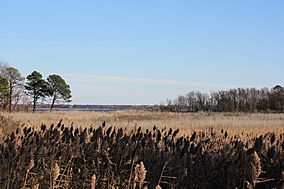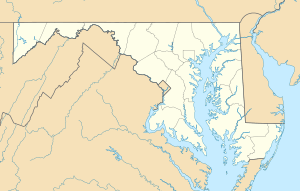Eastern Neck National Wildlife Refuge facts for kids
Quick facts for kids Eastern Neck National Wildlife Refuge |
|
|---|---|
|
IUCN Category IV (Habitat/Species Management Area)
|
|

A view to the south from the Duck Inn trail
|
|
| Location | Kent County, Maryland, United States |
| Nearest city | Rock Hall, Maryland |
| Area | 2,286 acres (9.25 km2) |
| Established | 1962 |
| Governing body | U.S. Fish and Wildlife Service |
| Website | Eastern Neck National Wildlife Refuge |
Eastern Neck National Wildlife Refuge is a special island where nature thrives. It's part of the Chesapeake Marshlands National Wildlife Refuge Complex. This island is about 2,286 acres (9.25 km2) big. It sits where the Chester River meets the huge Chesapeake Bay.
The refuge was created in 1962. Its main goal is to protect birds that travel long distances. Over 240 types of birds live here. This includes amazing bald eagles and fast peregrine falcons. It's also a major stop for tundra swans. Eastern Neck Island was one of the first places settled in Maryland.
Contents
Discovering Eastern Neck's Past
Eastern Neck Island has a long and interesting history.
Who Lived Here First?
Long ago, Woodland period Native Americans visited the island. They left behind clues like shell piles, arrowheads, and pottery. These items show that people lived and hunted here.
Early Settlers and Farmers
In the 1600s, Joseph Wickes and Thomas Hynson bought the whole island. They started farming the land. Joseph Wickes built a large house called "Wickliffe." His great-grandson, Captain Lambert Wickes, was a famous naval captain. There is a monument on the island to remember him. The Wickes family owned the island until 1902. They grew many different crops.
From Hunting Grounds to Wildlife Haven
After 1902, parts of the island became places for hunting. Rich people from nearby cities came to hunt waterfowl. The building that is now the visitor center was built as a hunting lodge in 1930.
In the 1950s, someone wanted to build many houses on the island. But local people were worried about this plan. So, the United States Fish and Wildlife Service bought the entire island. This happened between 1962 and 1967. This helped save the land for wildlife. The only house built for the housing plan is now used by park staff.
Fun at Ingleside Recreation Area
The Kent County Department of Parks and Recreation helps manage a spot called Ingleside Recreation Area. It's open from May to September. Here, you can go crabbing or launch small boats.
A Model for Nature Protection
Eastern Neck National Wildlife Refuge is a great example of how to protect land. It shows how to farm in a way that helps nature. It also works to bring back wetlands and plant native plants. This helps the whole Chesapeake Bay area.
Visiting the Refuge Today
More and more people are visiting Eastern Neck National Wildlife Refuge. Over 70,000 visitors come each year. They enjoy the beautiful water views and peaceful walking trails. It's a great place to see wildlife!
Green Energy at the Refuge
Eastern Neck Island is special because it uses clean energy.
Wind Power on the Island
In 2002, Eastern Neck Island became the first National Wildlife Refuge to have a wind turbine. This project was made possible with money from the Maryland Energy Administration and the United States Department of Energy. The project also included building a solar energy system.
The wind turbine is 60 feet (18 meters) tall. It has three blades that cover an area 23 feet (7 meters) wide. It helps power the main office building. It also shows people how renewable energy works. Experts also study if the turbine affects birds. They want to make sure it's safe for them. The turbine is designed to make about 10,000 kilowatt-hours of electricity each year.
Solar Power Too!
The refuge also has two groups of solar panels. These panels create electricity from the sun. They can make 150 and 167 watts of power.
Things to Do at Eastern Neck
Eastern Neck Island offers many fun activities for visitors.
Exploring the Island Roads
Eastern Neck Island Road starts at the Tundra Swan Boardwalk. This is near the refuge's entrance. The road goes down the middle of the island to the Wickliffe Historic Site. All the trails and activities are found off this main road.
Hiking and Wildlife Watching
There are almost six miles of roads and trails open to visitors. You can explore different parts of the refuge. Three wildlife trails and a boardwalk are available. The boardwalk is easy to use for everyone. It also has an observation tower. These spots are great for seeing the different habitats.
Popular trails include:
- The Tidal Marsh Overlook trail
- The Bayview/Butterfly trail
- The Duck Inn trail
- The Boxes Point trail
The Boxes Point trail is a favorite spot to see bald eagles!
Other Fun Activities
Besides hiking and bird watching, you can also enjoy:
- Boating
- Crabbing
- Fishing
- Hunting (in certain areas and seasons)
- Biking
Amazing Wildlife at the Refuge
Eastern Neck National Wildlife Refuge is home to many different animals.
Birds, Birds, Everywhere!
The refuge has recorded 243 different kinds of birds! In winter, you can see many ducks like lesser scaup, long-tailed ducks, white-winged scoters, ruddy ducks, canvasbacks, buffleheads, redheads, and pintails.
Many marsh and shore birds stop here during spring and fall migrations. Some birds even nest at the refuge. These include Mallards, American black ducks, wood ducks, great blue herons, and green herons.
Birds of Prey
Birds that hunt other animals are also common here. Bald eagles have raised their young on the island every year since 1986. Osprey build their nests in the spring and fly south before fall. You can also see many turkey vultures throughout the year.
Images for kids





